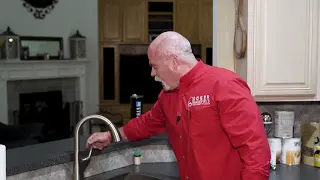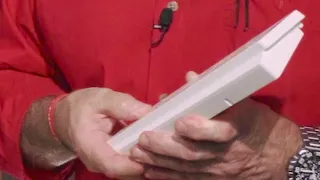Plumbing systems rarely follow straight lines without interruption. Joists, studs, existing piping, and other structural elements often force plumbers to change direction. Offsets are used to navigate around these obstacles while maintaining proper pitch and alignment. A 45-degree offset is one of the most common angles used for:
- Vents going through roofs
- Waste lines circumventing framing
- Drain systems that need to avoid structural beams or other services
When you know how to measure and cut an offset correctly, you’ll waste less pipe, avoid unnecessary leaks, and ensure your system flows smoothly. This accuracy is especially critical if you’re testing for a plumbing license or if you aim to uphold a professional reputation on the job.
Gathering Initial Measurements
Center-to-center distance
The foundation of any offset calculation is the center-to-center (C-to-C) distance between the two pipes you want to connect. In the example from the video transcript, we have two vertical pipes that must be linked with a 45-degree offset. The distance between their centers is measured as 12 inches.
In practice, you might measure center-to-center by:
- Holding your tape measure directly against the center of one pipe and aligning it with the center of the other pipe.
- Checking from outside edge to outside edge (or outside to inside) if the pipes are the same diameter. This approach can be easier than trying to guess the exact midpoint.
- Verifying the measurement in multiple ways to ensure consistency.
In the demonstration, the plumber verifies this 12-inch distance three different ways to be absolutely sure.
The Multiplier: 1.41 for 45-Degree Offsets
Plumbing math is more straightforward than it might first appear. For a 45-degree offset, the universal multiplier is 1.41. You multiply your measured center-to-center distance by 1.41 to figure out the total length of your “travel piece” (the diagonal stretch of pipe between the two 45-degree fittings).
- Example: If your offset distance is 12 inches, then
12 inches x 1.41 = 16.92 inches (which you might round to 16⅞ or 16 and 15/16 inches).
Why 1.41? A 45-degree offset is essentially the legs of a right triangle with equal angles (45–45–90). In a 45–45–90 triangle, the hypotenuse is 2\sqrt{2} times the length of each leg. The approximate value of 2\sqrt{2} is 1.414, usually simplified to 1.41 for quick plumbing calculations.
Accounting for Fitting Make Up
Even after calculating your diagonal length, you still need to subtract the portion of pipe that slips into each 45-degree fitting. This portion is called the “make up” (sometimes also referred to as “socket depth” or “insertion depth”).
In the demonstration, the plumber checks a reference sheet from Charlotte Pipe and Foundry that shows how much of the pipe fits inside a standard PVC (or ABS) 45-degree fitting. For 3-inch PVC, the make up might be around 1½ inches. That means each fitting will consume 1½ inches of your diagonal pipe length, for a total of 3 inches across two fittings.
- Calculation Recap:
- Multiply offset (12 inches) by 1.41 = 16.92 inches
- Subtract total fitting make up (3 inches) = 13.92 inches
- Round or convert to fractions (13 and 15/16 inches is close to 13.94 inches)
This final number (about 13⅞ or 13 and 15/16) is the length of pipe you cut for the diagonal piece.
Cutting the Pipe
In the video, the plumber cuts the diagonal piece to the required length and then deburrs (or reams) the inside and outside edges:
- Mark the Pipe: Measure carefully and mark the cut line.
- Cut Cleanly: Use a power saw, handsaw, or cutting tool of choice. Make sure the blade lines up exactly with your mark to maintain precision.
- Deburr the Edges: Smooth the cut edge on both the inside and outside. Any leftover plastic burrs can catch debris or hamper a secure seal.
With the diagonal piece ready, the plumber places the fittings on either end (without gluing) to do a quick “dry fit” and check that the center-to-center alignment hits the 12 inches needed.
Assembling the Offset
Once you have the diagonal piece and two 45-degree fittings, you can test the assembly:
- Attach the First 45: Slide the fitting onto the lower pipe (or whichever end is more convenient).
- Add the Diagonal Pipe: Insert the cut piece into the first fitting, ensuring it sits fully in the socket.
- Attach the Second 45: Fit the second 45-degree angle on the diagonal piece.
- Check Alignment: Verify that the other end of the second 45 lines up directly with the center of the second pipe.
The plumber in the video notes that he is working with a practice assembly (a trainer), so everything is intentionally left unglued for demonstration. In a real-world scenario, you would prime and glue the connections. If it’s a tight space, you’d likely secure the diagonal piece in the lower fitting first, then twist or align the upper fitting to ensure a perfect center match before the glue sets.
Dealing with Vertical Constraints
In many cases, you’ll have limited room to manipulate the pipes. The plumber in the video explains how you might have to push a vent stack up through a roof flashing to gain enough space for your diagonal piece. If you can’t move the top pipe easily, you might need to:
- Plan Your Cuts Precisely: Measure from where the fitting will seat to ensure everything lines up.
- Use a Slip Coupling: In certain circumstances, you can use a slip coupling (if code allows) to slide the pipe in place.
- Work from an Access Panel or Removed Section of Drywall: Sometimes, you’ll need to open a wall or ceiling to maneuver a new offset.
Checking Your Work
Before final assembly, do these checks:
- Dry Fit: Insert pipe into fittings without glue. This step helps confirm the center-to-center alignment and reveals if any adjustments are necessary.
- Measure Again: Confirm that the total offset is exactly your desired distance (12 inches in this example).
- Angle Verification: Use a level or angle finder to ensure your fittings are truly at 45 degrees. If they’re off, the center lines won’t align properly.
Additional Tips and Tricks
- Use Manufacturer Data: Many pipe and fitting manufacturers, such as Charlotte Pipe, provide charts showing socket depth (make up), angle multipliers, and other relevant dimensions. You can often find these in printed catalogs or apps.
- Memorize Common Multipliers:
- 45 degrees = 1.41
- 22½ degrees = 2.61 (actually 2.613 for offset-l eg calculations—some plumbers know this one by heart)
- Other angles can be derived using trigonometry, but 45 and 22½ are the most frequent in typical residential plumbing.
- Stovepiping (Eyeballing): Some old-school plumbers simply hold a fitting up, estimate the diagonal, and mark it by sight. While that can work with experience, it’s more efficient and reliable to use the proper math—especially if you’re taking a licensing exam.
- Check Local Codes: Offsets, venting angles, and the type of fittings allowed (e.g., long-sweep, short-sweep, or double 45s) can vary by code. Always ensure your work meets local plumbing regulations.
- Glue in Steps: If working in a cramped area, glue the easiest-fitting side first, then maneuver the pipe into position for the second fitting. You may need to angle or rotate the fittings just enough to slide everything in.
Common Mistakes to Avoid
- Forgetting to Subtract Fitting Make Up: If you don’t account for the 1½-inch insertion depth (or whatever depth your fittings have), you’ll end up with a diagonal piece that’s too long. This often results in wasted material and a frustrating do-over.
- Rounding Too Aggressively: While most plumbers round to the nearest 1/16 inch, rounding errors can accumulate. Precision is key for a neat installation.
- Forgetting Dry Fit: Testing your pieces in place before gluing can save you time and materials. Even the best measurements can go awry if you’re working in an older home with slight pipe misalignments.
- Overcomplicating the Process: The math is straightforward once you remember the key formula. Avoid confusion by having a clear system: measure, multiply, subtract make up, and mark your pipe.
Sponsored by Leak Pro
This post is inspired by the same content showcased in Roger Wakefield’s video, sponsored by Leak Pro (Leak-Pro.com). Whether you’re a seasoned plumber looking to broaden your service offerings or a business owner wanting to train your team on leak detection technology, Leak Pro has the tools and expertise to help you:
- Pinpoint hidden leaks faster
- Offer high-value services to customers
- Enhance your plumbing operations with cutting-edge equipment and training
Visit Leak-Pro.com to learn how they can help you upgrade your skills, streamline your workflow, and better serve your clients.
Conclusion
Measuring a 45-degree offset might seem like an intimidating process for newcomers, but once you understand the center-to-center measurement, the 1.41 multiplier, and the fitting make up, everything becomes more manageable. The key steps—double-checking your measurements, subtracting the correct amount for each fitting, and verifying alignment with a dry fit—will ensure that you hit your target distance every time.
This technique is invaluable for running vents, bypassing obstacles in a waste line, or adjusting drain lines around structural elements. Mastering it will help you:
- Save time on every job
- Reduce wasted materials
- Impress inspectors with consistent, professional work
- Stay confident on your licensing exams
If you’re a plumber already familiar with this method, consider whether you can speed up the process by using an app or a reference sheet from your preferred manufacturer. If you’re new to plumbing, practice these calculations on scrap pieces until you feel comfortable—before tackling a live job.
Now that you know how to measure and cut a 45-degree offset, you can handle a wide range of pipe-fitting tasks with precision and efficiency. And remember, if you ever need advanced leak detection training or equipment, Leak Pro can set you up for success in the modern plumbing market.




